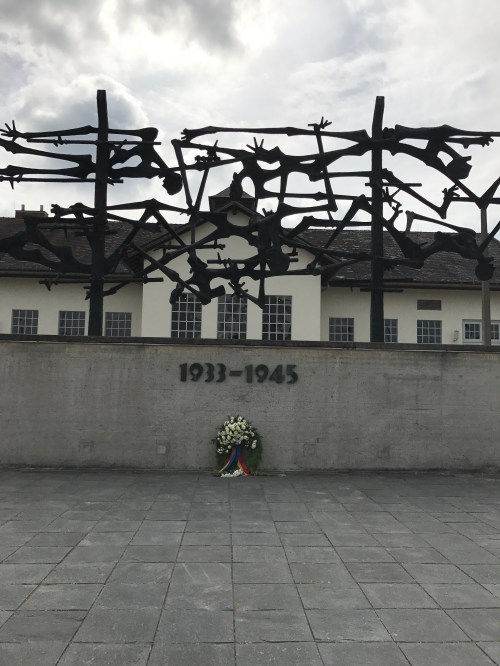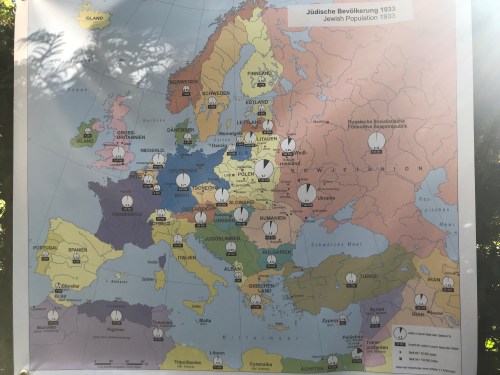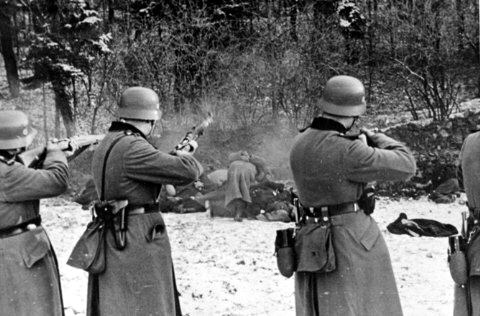
Friends of Padre Steve’s World,
I return again to the Nuremberg Trials and the opening statement of the American Chief Prosecutor, Supreme Court Justice Robert Jackson.
The nine volumes of the trial proceedings are something that anyone that studies the Nazi period, or international law must read. In reading them one gets a feel for the process itself and the overall fairness of it.
Jackson’s opening and closing statements in the trial are considered to be among the most important and compelling addresses in legal history, as well as masterful rhetoric which connected with the audience and still do today. One legal analyst wrote:
The form components connected with all who participated as an audience at the time and kept the attentiveness of the audience, to change international criminal law forever. The settings broke, and notably continue to break, down the barriers for even those who still read the discourse today. Finally, the narrative’s connectivity is an absolute active function, as the memory and legacy of the tragedy that the Nazis inflicted upon humanity will forever evoke emotion for anyone exposed to this opening statement… With its emotional charge, legal rationale, and human viewpoint, it cannot be denied that this narrative not only held a strong rhetorical effectiveness for the judicial panel hearing the case, but also the world at the time it was given. Patrick Iyampillai, “A Grave Responsibility: A Rhetorical Critique of the Opening Statement at Nuremberg Using the Narrative Perspective”
I have posted with commentary Jackson’s introduction, and his discussion of the Nazi battles against Free Labor Unions, and the Churches. Today I move on to his discussion of the criminal racial Nazi War Against the Jews in Germany and across occupied Europe. This is one of the most important aspects of his opening statement because of its relevance today as anti-Semitism and violence against Jews grows more open and more common in Europe and the United States.

When you read them you get a sense of the moral authority that Jackson championed and the manner in which he tied these crimes in to the the crimes that he previously had dealt with in his speech before the tribunal.
I have read many authoritative histories of the Holocaust and the Nazi genocide committed against the Jews. I have also read the accounts of the Nazi perpetrators. These are vitality important, but what is often missing from them is Jackson’s skill as a prosecutor to hammer away at the guilt of those who committed these heinous actions. Sometimes a detached historian attempting to convey the facts, fails provide the moral rhetoric of a prosecutor to fully convey the extent of the evil that was committed by the Nazis Against the Jews. Thus, Jackson’s speech should be a jumping off point before one begins to study the Holocaust. It may not sound fair, but one has to understand the moral outrage of the Nazi crimes before one can appreciate the truth about the Nazi crimes.
https://encyclopedia.ushmm.org/content/en/film/screening-of-concentration-camp-film-footage
Sadly, the crimes of the Nazis evoke little outrage today. When neo-Nazis demonstrated in Charlottesville in the summer of 2017, killing a counter-protestor and beating others, President Trump equivocated and said that there “were very good people on both sides.” Time after time we witness the spectacle of political leaders in the United States, Hungary, Poland, Germany, France, and Russia using blatant anti-Semitism, and racism to remind others that they are the superior race; and most of their supporters make no protest. The examples of their political words, and the crimes directly linked to racism and anti-Semitism are now far too numerous to even bother to list, and they are added to on what seems like a daily basis.

Do not get me wrong, history is important, facts matter, and anti-Semitism and racism are a poison that seems to infect the human race. Historian Christopher Browning wrote:
“I fear that we live in a world in which war and racism are ubiquitous, in which the powers of government mobilization and legitimization are powerful and increasing, in which a sense of personal responsibility is increasingly attenuated by specialization and bureaucratization, and in which the peer group exerts tremendous pressures on behavior and sets moral norms. In such a world, I fear, modern governments that wish to commit mass murder will seldom fail in their efforts for being unable to induce “ordinary men” to become their “willing executioners.”
The Nazis were guilty. Their crimes were horrific, and one cannot as a human being simply relegate them to the depths of history when before our eyes their apologists seek to again use race hatred to gain power; in some countries they are The stakes are far too high. As historian Timothy Snyder has so poignantly written:
“The European history of the twentieth century shows us that societies can break, democracies can fall, ethics can collapse, and ordinary men can find themselves standing over death pits with guns in their hands. It would serve us well today to understand why.”
The fact is what happened in the Holocaust was not an aberration of human nature. Genocide is not confined to the Nazis. Rwanda, Cambodia, Armenia, the Balkans, Nanking, Stalin’s genocide of Ukrainians, Kazakhs, Belorussians, and other non-Russian citizens of the Soviet Union, and the American extermination of the indigenous Native American tribes are not ancient history. Historian Gerhard Weinberg wrote:
“It’s very, very important for people to get a sense of what the potentialities of people really are, what the dangers of ignorance can be. It is in this context, that a supposedly advanced society risks descending into the sewer, that the Holocaust is a warning to people who think of themselves as an advanced, modern society

With that, I give you Jackson’s dissection of the Nazi Crimes Against the Jews which he delivered on the afternoon of November 21st, 1945.
The most savage and numerous crimes committed by the Nazis were those against the Jews. Those in Germany, in 1933, numbered about 500,000. In the aggregate, they had made for themselves positions which excited envy, and had accumulated properties which excited the avarice of the Nazis. They were few enough to be helpless and numerous enough to be held up as a menace.
Let there be no misunderstanding about the charge of persecuting Jews. What we charge against these defendants is not those arrogances and pretensions which frequently accompany the intermingling of different peoples and which are likely, despite the honest efforts of Government, to produce regrettable crimes and convulsions. It is my purpose to show a plan and design to which all Nazis were fanatically committed to annihilate all Jewish people. These crimes were organised and promoted by the Party Leadership, executed and protected by the Nazi officials, as we shall convince you by written orders of the Secret State Police itself.
The persecution of the Jews was a continuous and deliberate policy. It was a policy directed against other nations as well as against the Jews themselves. Anti-Semitism was promoted to divide and embitter the democratic peoples and to soften their resistance to the Nazi aggression. As Robert Ley declared in Der Angriff on 14 May, 1944, “the second German secret weapon is Anti-Semitism because, if it is constantly pursued by Germany, it will become a universal problem which all nations will be forced to consider.”
Anti-Semitism also has been aptly credited with being a “spearhead of terror.” The ghetto was the laboratory for testing repressive measures. Jewish property was the first to be expropriated, but the custom grew and included similar measures against Anti-Nazi Germans, Poles, Czechs, Frenchmen, and Belgians. Extermination of the Jews enabled the Nazis to bring a practised hand to similar measures against Poles, Serbs, and Greeks. The plight of the Jew was a constant threat to opposition or discontent among other elements of Europe’s population -Pacifists, Conservatives, Communists, Catholics, Protestants, Socialists. It was in fact, a threat to every dissenting opinion and to every non-Nazi’s life.
The persecution policy against the Jews commenced with non-violent measures, such as disfranchisement and discriminations against their religion, and the placing of impediments in the way of success in economic life. It moved rapidly to organised mass violence against them, physical isolation in ghettos, deportation, forced labour, mass starvation, and extermination. The Government, the Party formations indicted before you as criminal organisations, the Secret State Police, the Army, private and semi-public associations, and “spontaneous” mobs that were carefully inspired from official sources, were all agencies that were concerned in this persecution. Nor was it directed against individual Jews for personal bad citizenship or unpopularity. The avowed purpose was the destruction of the Jewish people as a whole, as an end in itself, as a measure of preparation for war, and as a discipline for conquered peoples.
The conspiracy or common plan to exterminate the Jew was so methodically and thoroughly pursued, that despite the German defeat and Nazi prostration this Nazi aim largely has succeeded. Only remnants of the European Jewish population remain in Germany, in the countries which Germany occupied, and in those which were her satellites or collaborators. Of the 9,600,000Jews who lived in Nazi-dominated Europe, 6o per cent. are authoritatively estimated to have perished-5,700,000 Jews are missing from the countries in which they formerly lived, and over 4,500,000 cannot be accounted for by the normal death rate nor by immigration; nor are they included among displaced persons. History does not record a crime ever perpetrated against so many victims or one ever carried out with such calculated cruelty.
You will have difficulty, as I have, to look into the faces of these defendants and believe that in this Twentieth Century human beings could inflict such sufferings as will be proved here, on their own countrymen as well as upon their so-called “inferior” enemies. Particular crimes, and the responsibility defendants for them, are to be dealt with by the Soviet Government’s Counsel, when committed in the East, and by Counsel for the Republic of France committed in the West. I advert to them only to show their magnitude as evidence of a purpose and a knowledge common to all defendants, of an official plan rather than of a capricious policy of some individual commander, and to show such a continuity of Jewish persecution, from the rise of the Nazi conspiracy to its collapse, as forbids us to believe that any person could be identified with any part of Nazi action without approving this most conspicuous item in their programme.
The Indictment itself recites many evidences of the anti-Semitic persecutions. The defendant Streicher led the Nazis in anti-Semitic bitterness and extremism. In an article appearing in Der Sturmer on 19th March, he complained that Christian teachings have stood in the way of “racial solution of the Jewish question in Europe,” and quoted enthusiastically as the Twentieth Century solution the Fuehrer’s proclamation Of 24th February, 1943, that “the Jew will be exterminated.” And on 4th November, 1943, Streicher declared in Der Sturmer that the Jews “have disappeared from Europe and that the Jewish ‘Reservoir of the East’ from which the Jewish plague has for centuries beset the people of Europe, has ceased to exist.” Streicher now has the effrontery to tell us he is “only a Zionist”; he says he only wants to return the Jews to Palestine.

But on 7th May, 1942, his newspaper Der Sturmer had this to say: “It is also not only a European problem! The Jewish question is a world question! Not only is Germany not safe in the face of the Jews as long as one Jew lives in Europe, but also the Jewish question is hardly solved in Europe so long as Jews live in the rest of the world.”
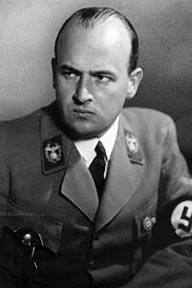
Hitler’s Lawyer and Governor General of Occupied Poland
And the defendant Hans Frank, a lawyer by profession I say with shame, summarised in his diary in 1944 the Nazi policy thus:
“The Jews are a race which has to be eliminated; whenever we catch one, it is his end.” (Document No. 2233-PS, Vol. 1944, p. 26.)
And earlier, speaking of his function as Governor-General of Poland, he confided to his diary this sentiment:
“Of course I cannot eliminate all lice and Jews in only a year’s time.” (2233-PS, Vol. IV, 1940, p. 1159)
I could multiply endlessly this kind of Nazi ranting, but I will leave it to the evidence and turn to the fruit of this perverted thinking.
The most serious of the actions against Jews were outside of any law, but the law itself was employed to some extent. There were the infamous Nuremberg decrees of 15th September, 1935. (” Reichsgesetzblatt,” 1935, Part 1, p. 1146.) The Jews were segregated into ghettos and put into forced labour; they were expelled from their professions; their property was expropriated; all culturallife, the Press, the theatre, and schools were prohibited them; and the S.D. was made responsible for them. (212-PS, 069-PS.) This was an ominous guardianship as the following order for “The Handling of the Jewish Question” shows:
“The competency of the Chief of the Security Police and Security Service, who is charged with the mission of solving the European Jewish question, extends even to the occupied eastern provinces. . . .
An eventual act by the civilian population against the Jews is not to be prevented as long as this is compatible with the maintenance of order and security in the rear of the fighting troops. . . .
The first main goal of the German measures must be the strict segregation of Jewry from the rest of the population. In the execution of this, first of all, is the seizing of the Jewish populace by the introduction of a registration order and similar appropriate measures…
Then immediately, the wearing of the recognition sign, consisting of a yellow Jewish star, is to be brought about and all rights of freedom for Jews are to be withdrawn. They are to be placed in ghettos, and at the same time, are to be separated according to sex. The presence of many more or less closed Jewish settlements in White Ruthenia and in the Ukraine makes this mission easier. Moreover, places are to be chosen which make possible the full use of the Jewish manpower in case labour needs are present. The entire Jewish property is to be seized and confiscated, with the exception of that which is necessary for a bare existence. As far as the economical situation permits, the power of disposal of their property is to be taken from the Jews as soon as possible through orders and other measures given by the commissariat, so that the moving of property will quickly cease.”
“Any cultural activity will be completely forbidden to the Jew. This includes the outlawing of the Jewish Press, the Jewish theatres and schools.
“The slaughtering of animals according to Jewish rites is also to be prohibited.” (212-PS).
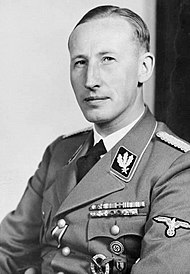
Obergrüppenfuhrer Reinhard Heydrich
The anti-Jewish campaign became furious following the assassination in Paris of the German Legation Councillor von Rath. Heydrich, Gestapo head, sent a telegram to all Gestapo and S.D. offices with directions for handling “spontaneous” uprisings anticipated for the nights of 9th and 10th November, 1938, so as to aid in destruction of Jewish-owned property and protect that of Germans. No more cynical document ever came into evidence. Then there is a report by an S.S. Brigade Leader, Dr. Stahlecher to Himmler, which recites that:
“Similarly, native anti-Semitic forces were induced to start pogroms against Jews after capture, though this inducement proved to be very difficult.
Following out orders, the Security Police was determined to solve the Jewish question with all possible means and most decisively. But it was desirable that the Security Police should not put in an immediate appearance, at least at the beginning, since the extraordinarily harsh measures were apt to stir even German circles. It had to be shown to the world that the native population itself took the first action by way of natural reaction against the suppression by Jews during several decades and against the terror exercised by the Communists during the preceding period.”
In view of the extension of the area of operations and the great number of duties which had to be performed by the Security Police, it was intended from the very beginning to obtain the co-operation of the reliable population for the fight against vermin – that is mainly the Jews and Communists. Beyond our directing of the first spontaneous actions of self-cleansing, which will be reported elsewhere, care had to be taken that reliable people should be put to the cleansing job, and that they were appointed auxiliary members of the Security Police.”
Kowno. To our surprise it was not easy at first to set in motion an extensive pogrom against Jews. Klimatis, the leader of the partisan unit, mentioned above, who was used for this purpose primarily, succeeded in starting a pogrom on the basis of advice given to him by a small advanced detachment acting in Kowno, and in such a way that no German order or German instigation was noticed from the outside. During the first pogrom in the night from 25 to 26.6 the Lithuanian partisans did away with more than 1,500 Jews, set fire to several Synagogues or destroyed them by other means and burned down a Jewish dwelling district consisting of about 60 houses. During the following nights about 2,300 Jews were made harmless in a similar way. In other parts of Lithuania similar actions followed the example of Kowno, though smaller and extending to the Communists who had been left behind.
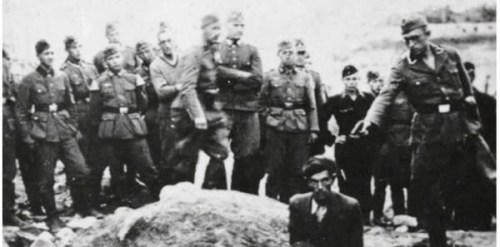
These self-cleansing actions went smoothly because the Army authorities who had been informed showed understanding for this procedure. From the beginning it was obvious that only the first days after the occupation would offer the opportunity for carrying out pogroms. After the disarmament of the partisans the self-cleansing actions ceased necessarily.
It proved much more difficult to set in motion similar cleaning actions in Latvia.”
From the beginning it was to be expected that the Jewish problem in the East could not be solved by pogroms alone. In accordance with basic orders received, however, the cleansing activities of the Security Police had to aim at the complete annihilation of the Jews…
“The sum total of Jews liquidated in Lithuania amounts to 71,105. . . .” (L-180)
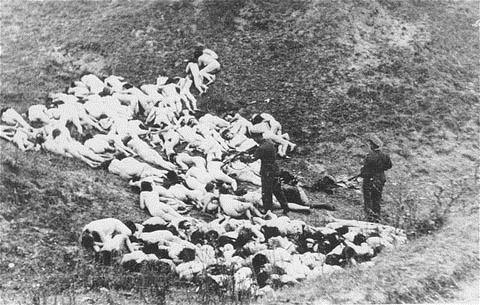
Of course, it is self-evident that these “uprisings” were managed by the government and the Nazi Party. If we were in doubt, we could resort to Streicher’s memorandum of 14th April, 1939, which says, “The anti-Jewish action of November, 1938, did not arise spontaneously from the people.. Part of the party formation has been charged with the execution of the anti-Jewish action.” (406-PS) Jews as a whole were fined a billion Reichsmarks. They were excluded from all businesses, and claims against insurance companies for their burned properties were confiscated, all by the decree of the defendant Goering. (Reichsgesetzblatt, 1938, Part 1, pp. 1579-1582.)
Synagogues were the objects of a special vengeance. On 10th November, 1938, the following order was given: “
“By order of the Group Commander, all Jewish Synagogues in the area of Brigade 50 have to be blown up or set afire. The operation will be carried out in civilian clothing…. Execution of the order will be reported….( 1721-PS.) Some 40 teletype messages, from police headquarters, which will be introduced to you, will tell the fury with which all Jews were pursued in Germany on those awful November nights. The S.S. troops were turned loose and the Gestapo supervised. Jewish-owned property was destroyed. The Gestapo ordered twenty to thirty thousand “well-to-do Jews” to be arrested. Concentration camps were to receive them and the order provided healthy Jews, fit for labour, were to be taken (3051-PS).

As the German frontiers were expanded by war, so the campaign against the Jews expanded. The Nazi plan never was limited to Germany; always it contemplated extinguishing the Jew in Europe and often in the world. In the West, the Jews were killed and their property, taken over. But the campaign achieved its zenith of savagery in the East. The Eastern Jew has suffered as no people ever suffered. Their sufferings were carefully reported to the Nazi authorities to show faithful adherence to the Nazi design. I shall refer only to enough of the evidence of these to show the extent of the Nazi design for killing Jews.
If I should recite these horrors in words of my own, you would think me intemperate and unreliable. Fortunately, we need not take the word of any witness but the Germans themselves. I invite you now to look at a few of the vast number of captured German orders and reports that will be offered in evidence, to see what a Nazi invasion meant. We will present such evidence as the report of “Einsatzgruppe (Action Group) A” of 15th October, 1941, which boasts that in overrunning the Baltic States, “Native Anti-Semitic forces were induced to start pogroms against the Jews during the first hours after occupation.” The report continues:
“From the beginning it was to be expected that the Jewish problem in the East could not be solved by pogroms alone. In accordance with the basic orders received, however, the cleansing activities of the Security Police had to aim at a complete annihilation of the Jews. Special detachments reinforced by selected units -in Lithuania partisan detachments, in Latvia units of the Latvian auxiliary police -therefore performed extensive executions both in the towns and in rural areas. The actions of the execution detachments were performed smoothly.”

“The sum total of the Jews liquidated in Lithuania, according to the report, amounts to 71,105. During the pogroms in Kowno 3,800 Jews were eliminated, in the smaller towns about 1,200 Jews.”

“In Latvia, up to now a total of 30,000 Jews was executed. Five hundred were eliminated by pogroms in Riga.” (L-180.)
This is a captured report from the Commissioner of Sluzk on 20th October, 1941, which describes the scene in more detail.
It says:-“… The first lieutenant explained that the police battalion had received the assignment to effect the liquidation of all Jews here in the town of Sluzk, within two days … Then I requested him to postpone the action one day. However, he rejected this with the remark that he had to carry out this action everywhere and in all towns and that only two days were allotted for Sluzk. Within these two days the town of Sluzk had to be cleared of Jews by all means … All Jews without exception were taken out of the factories and shops and deported in spite of our agreement. It is true that part of the Jews was moved by way of the ghetto, where many of them were processed and still segregated by me, but a large part was loaded directly on trucks and liquidated without further delay outside of the town.. For the rest, as regards the execution of the action, I must point out to my deepest regret that the latter bordered already on sadism. The town itself offered a picture of horror during the action. With indescribable brutality on the part of the German police officers and particularly the Lithuanian partisans, the Jewish people, but also among them White Ruthenians, were taken out of their dwellings and herded together. Everywhere in the town shots were to be heard and in different streets the corpses of shot Jews accumulated. The White Ruthenians were in greatest distress to free themselves from the encirclement. Regardless of the fact that the Jewish people, among whom were also tradesmen, were mistreated in a terribly barbarous way in the face of the White Ruthenian people, the White Ruthenians themselves were also worked over with rubber clubs and rifle butts. There was no question of an action against the Jews anymore. It rather looked like a revolution…”( 1104-PS.)
There are reports which merely tabulate the numbers slaughtered. Another example is an account of the work of Einsatzgruppen of Sipo and S.D. in the East which relates that “in Estonia, all Jews were arrested immediately upon the arrival of the Wehrmacht.”
Jewish men and women above the age of sixteen and capable of work were drafted for forced labour. Jews were subjected to all sorts of restrictions and all Jewish property was confiscated.
All Jewish males above the age of sixteen were executed, with the exception of doctors and elders. Only 500 of an original 4,500 Jews remained.
37,180 persons have been liquidated by the Sipo and S.D. in White Ruthenia during October.
In one town, 337 Jewish women were executed for demonstrating a “provocative attitude.” In another, 380 Jews were shot for spreading vicious propaganda.
And so the report continues, listing town after town, where hundreds upon hundreds of Jews were murdered.
In Vitebsk 3,000 Jews were liquidated because of the danger of epidemics.
In Kiev, 33,771 Jews were executed On 29th/ 30th September in retaliation for some fires which were set off there.
In Zhitomir, 3,145 Jews “had to be shot” because, judging from experience they had to be considered as the carriers of Bolshevik propaganda.

In Kherson, 410 Jews were executed in reprisal against acts of sabotage. In the territory east of the Djnepr, the Jewish problem was “solved” by the liquidation Of 4,891 Jews and by putting the remainder into labour battalions of up to 1,000 persons. (R-102.)
Other accounts tell not of the slaughterso much as of the depths of degradation to which the tormentors stooped. For example, we will show the report made to defendant Rosenberg about the Army and the S.S. in the area under Rosenberg’s jurisdiction, which recited the following:
“Details in the presence of S.S. man, a Jewish dentist has to break all gold teeth and fillings out of mouth of German and Russian Jews before they are executed.”
Men, women and children are locked into barns and burned alive.
Peasants, women and children, are shot on the pretext that they are suspected of belonging to bands. (R-135.)
We of the Western world heard of gas wagons in which Jews and political opponents were asphyxiated. We could not believe it. But here we have the report of 16th May, I942, from the German S.S. Officer Becker, to his supervisor in Berlin, which tells this story;
“Gas vans in C group can be driven to execution spot, which is generally stationed ten to fifteen kilometres from main road, only in dry weather. Since those to be executed become frantic if conducted to this place, such vans become immobilised in wet weather.
Gas vans in D group were camouflaged as cabin trailers, but vehicles well known to authorities and civilian population which calls them ‘Death Vans.’
The writer of the letter, Becker, ordered all men to keep as far away as possible during gassing. Unloading van after the gassing has ‘atrocious spiritual and physical effect’ on men and they should be ordered not to participate in such work.” (501-PS.)
I shall not dwell on this subject longer than to quote one more sickening document which evidences the planned and systematic character of these Jewish persecutions. I hold a report written with Teutonic thoroughness as to detail, illustrated with photographs to authenticate its almost incredible text, and beautifully bound in leather with the loving care bestowed to a proud work. It is the original report of the S.S. Brigade General Stroop in charge of the destruction of the Warsaw Ghetto, and its title page carries the inscription, “The Jewish Ghetto in Warsaw no longer exists.” It is characteristic that one of the captions explains that the photograph concerned shows the driving out of Jewish “bandits”; those whom the photograph shows being driven out are almost entirely women and little children. It contains a day-by-day account of the killings mainly carried out by the S.S. Organisation, too long to relate, but let me quote General Stroop’s summary: “
“The resistance put up by the Jews and bandits could only be suppressed by energetic actions of our troops day and night. The Reichsfuehrer S.S. ordered therefore on 23rd April, 1943, the cleaning out of the ghetto with utter ruthlessness and merciless tenacity. I, therefore, decided to destroy and burn down the entire ghetto without regard to the armament factories. These factories were systematically dismantled and then burned. Jews usually left their hideouts, but frequently remained in the burning buildings and jumped out of the windows only when the heat became unbearable. They then tried to crawl with broken bones across the street into buildings which were not afire. Sometimes they changed their hideouts during the night into the ruins of burned buildings. Life in the sewers was not pleasant after the first week. Many times we could hear loud voices in them. S.S. men or policemen climbed bravely through the manholes to capture these Jews. Sometimes they stumbled over Jewish corpses; sometimes they were shot at. Tear gas bombs were thrown into the manholes and the Jews driven out of the sewers and captured. Countless numbers of Jews were liquidated in sewers and bunkers through blasting. The longer the resistance continued the tougher became the members of the Waffen S.S., Police and Wehrmacht, who always discharged their duties in an exemplary manner. Frequently Jews who tried to replenish. their food supplies during the night or to communicate with neighbouring groups were exterminated.” (1061-PS) “
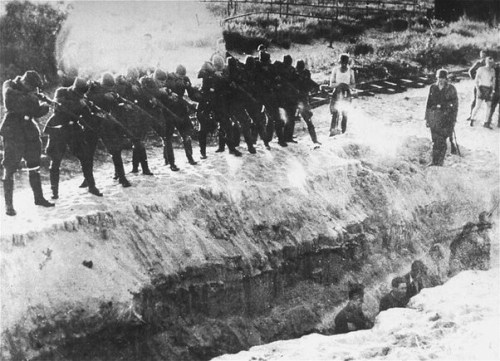
“This action eliminated,” says the S.S. commander, “a proved total of 56,065. To that we have to add the number killed through blasting, fire, etc., which cannot be counted.”
We charge that all atrocities against Jews were the manifestation and culmination of the Nazi plan to which every defendant here was a party. I know very well that some of these men did take steps to spare some particular Jew for some personal reason from the horrors that awaited the unrescued Jew. Some protested that particular atrocities were excessive, and discredited the general policy. While a few defendants may show efforts to make specific exceptions to the policy of Jewish extermination, I have found no instance in which any defendant opposed the policy itself or sought to revoke or even modify it.
Determination to destroy the Jews was a binding force which at all times cemented the elements of this conspiracy. On many internal policies there were differences among the defendants. But there is not one of them who has not echoed the rallying cry of Naziism: DEUTSCIILAND ERWACHE-JUDA VERRECKE (Germany Awake-Jewry Perish!)
I come to the discussion of terrorism and to preparation for the war.
How a Government treats its own inhabitants generally is thought to be no concern of other Governments or of international society. Certainly few oppressions or cruelties would warrant the intervention of foreign powers. But the German mistreatment of Germans is now known to pass in magnitude and savagery any limits of what is tolerated by modern civilisation. Other nations, by silence, would take a consenting part in such crimes. These Nazi persecutions, moreover, take character as international crimes because of the purpose for which they were undertaken.
The purpose, as we have seen, of getting rid of the influence of free labour, the churches and the Jews was to clear their obstruction to the precipitation of aggressive war. If aggressive warfare in violation of treaty obligation is a matter of international cognisance, the preparations for it must also be of concern to the international community. Terrorism was the chief instrument for securing the cohesion of the German people in war purposes. Moreover, these cruelties in Germany served as atrocity practice to discipline the membership of the criminal organisation to follow the pattern later in occupied countries.
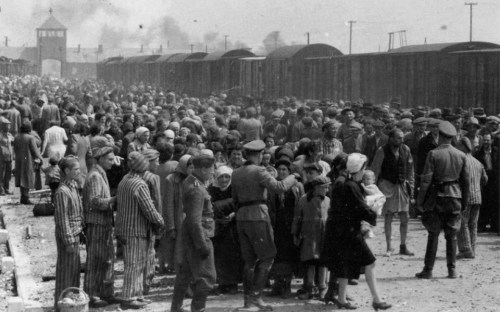
Through the police formations that are before you accused as criminal organisations, the Nazi Party leaders, aided at some point in their basic and notorious purpose by each of the individual defendants, instituted a reign of terror. These espionage and police organisations were utilised to hunt down every form of opposition and to penalise every nonconformity. These organisations early founded and administered concentration camps -Buchenwald in 1933, Dachau in 1934. But these notorious names were not alone. Concentration camps came to dot the German map and to number scores. At first they met with resistance from some Germans. We have a captured letter from Minister of Justice Gurtner to Hitler which is revealing. A Gestapo official had been prosecuted for crimes committed in a camp at Hohenstein, and the Nazi Governor of Saxony had promptly asked that the proceeding be quashed. The Minister of Justice in June of 1935 protested because, as he said, “In this camp unusually grave mistreatments of prisoners has occurred at least since Summer 1939. The prisoners not only were beaten with whips, without cause, similarly as in the Concentration Camp Bredow near Stettin until they lost consciousness, but they were also tortured in other manners, e.g., with the help of a dripping apparatus constructed exclusively for this purpose, under which prisoners had to stand until they were suffering from serious purulent wounds of the scalp.” (787-PS)
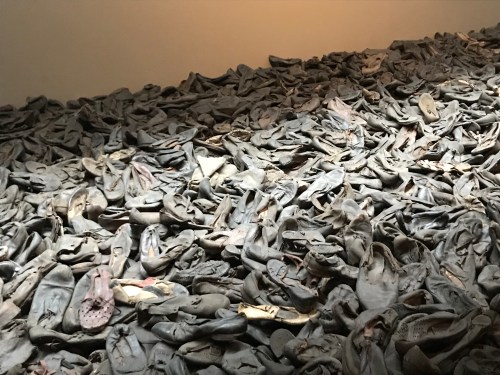
I shall not take time to detail the ghastly proceedings in these concentration camps. Beatings, starvings, tortures, and killings were routine -so routine that the tormentors became blase and careless. We have a report of discovery that in Plotzensee one night, 186 persons were executed while there were orders for only 150. Another report describes how the family of one victim received two urns of ashes by mistake. Inmates were compelled to execute each other. In 1942, they were paid five Reichsmarks per execution, but on 27th June, 1942, S.S. General Glucke ordered commandants of all concentration camps to reduce this honorarium to three cigarettes. In 1943, the Reichs leader of the S.S. and Chief of German Police ordered the corporal punishment on Russian women to be applied by Polish women and vice versa, but the price was not frozen. “As a reward, a few cigarettes” was authorised. Under the Nazis, human life had been progressively devalued, until it finally became worth less than a handful of tobacco -Ersatz tobacco. There were, however, some traces of the milk of human kindness. On 11th August, 1942, an order went from Himmler to the commandants of fourteen concentration camps that “only German prisoners are allowed to beat other German prisoners.” (2189-PS).
Mystery and suspense was added to cruelty in order to spread torture from the inmate to his family and friends. Men and women disappeared from their homes or business or from the streets, and no word came of them. The omission of notice was not due to overworked staff; it was due to policy. The Chief of the S.D. and Sipo reported that, in accordance with orders from the Fuehrer, anxiety should be created in the minds of the family of the arrested person. (668-PS.) Deportations and secret arrests were labelled, with a Nazi wit which seems a little ghoulish, “Nacht und Nebel” (Night and Fog). (L, 90, 833-PS.)
One of the many orders for these actions, gave this explanation:
“The decree carries a basic innovation. The Fuehrer and Commander-in-Chief of the Armed Forces commands that crimes of the specified sort by civilians of the occupied territories are to be punished by the pertinent courts martial in the occupied territories only when (a) the sentence calls for the death penalty; and (b) the sentence is pronounced within eight days of arrest. Only when both conditions are met does the Fuehrer and Commander-in Chief of the Armed Forces hope for the desired deterrent effect from the conduct of punitive proceedings in the occupied territories. In other cases in the future, the accused are to be secretly brought to Germany, and the further conduct of the trial carried on here. The deterrent effect of these measures lies (a) in allowing the disappearance of the accused without a trace; (b) therein that no information whatsoever may be given about their whereabouts and their fate.” (833-PS.)
To clumsy cruelty, scientific skill was added. “Undesirables” were exterminated by injection of drugs into the bloodstream, by asphyxiation in gas chambers. They were shot with poison bullets, to study the effects (L-103); Then, to cruel experiments the Nazi added obscene ones. These were not the work of underling-degenerates, but of master-minds high in the Nazi conspiracy. On 20th May, 1942, General Field Marshal Milch authorised S.S. General Wolff to go ahead at Dachau Camp with so-called “cold experiments”; and four female gypsies were selected for the purpose. Himmler gave permission to carry on these “experiments” also in other camps (1617-PS). At Dachau, the reports of the “doctor” in charge show that victims were immersed in cold water until their body temperature was reduced to 26 degrees centigrade (8.24 degrees Fahrenheit) when they all died immediately. (1618-PS.) This was in August, 1942. But the “doctor’s” technique improved. By February, 1943, he was able to report that thirty persons were chilled to 27 to 29 degrees, their hands and feet frozen white, and their bodies “rewarmed” by a hot bath. But the Nazi scientific triumph was “rewarming with animal heat.” The victim, all but frozen to death, was surrounded with the bodies of living women until he revived and responded to his environment by having sexual intercourse. (1616-PS.) Here Nazi degeneracy reached its nadir.
I dislike to encumber the record with such morbid tales, but we are in the grim business of trying men as criminals, and these are the things that their own agents say happened. We will show you these concentration camps in motion pictures. just as the Allied armies found them when they arrived, and the measures General Eisenhower had to take to clean them up. Our proof will be disgusting and you will say I have robbed you of your sleep. But these are the things which have turned the stomach of the world and set every civilised hand against Nazi Germany.
Germany became one vast torture chamber. Cries of its victims were heard round the world and brought shudders to civilised people everywhere. I am one who received during this war most atrocity tales with suspicion and skepticism. But the proof here will be so overwhelming that I venture to predict not one word I have spoken will be denied. These defendants will only deny personal responsibility or knowledge.
Under the clutch of the most intricate web of espionage and intrigue that any modern State has endured, and persecution and torture of a kind that has not been visited upon the world in many centuries, the elements of the German population which were both decent and courageous were annihilated. Those which were decent but weak were intimidated. Open resistance, which had never been more than feeble and irresolute, disappeared. But resistance, I am happy to say, always remained, although it was manifest in only such events as the abortive effort to assassinate Hitler on 20th July, 1944. With resistance driven underground, the Nazi had the German State in his own hands.

But the Nazis not only silenced discordant voices. They created positive controls as effective as their negative case. Propaganda organs, on a scale never before known, stimulated the party and party formations with a permanent enthusiasm and abandon such as we, democratic people, can work up only for a few days before a general election. They inculcated and practised the Fuehrer-prinzip which centralised control of the Party and of the Party-controlled State over the lives and thought of the German people, who are accustomed to look upon the German State, by whomever controlled, with a mysticism that is incomprehensible to my people.
All these controls, from their inception were exerted with unparalleled energy and single-mindedness to put Germany on a war footing. We will show from the Nazis’ own documents their secret training of military personnel, their secret creation of a military air force. Finally, a conscript army was brought into being. Financiers, economists, industrialists, joined in the plan and promoted elaborate alterations in industry and finance to support an unprecedented concentration of resources and energies upon preparations for war. Germany’s rearmament so outstripped the strength of her neighbours that in about a year she was able to crush the whole military force of Continental Europe, exclusive of that of Soviet Russia, and then to push the Russian armies back to the Volga. These preparations were of a magnitude which surpassed all need of defence, and every defendant, and every intelligent German, well understood them to be for aggressive purposes.
Before resorting to open aggressive warfare, the Nazis undertook some rather cautious experiments to test the spirit of resistance of those who lay across their path. They advanced, but only as others yielded, and kept in a position to draw back if they found a temperament that made persistence dangerous.
On 7th March, 1936, the Nazis reoccupied the Rhineland and then proceeded to fortify it in violation of the Treaty of Versailles and the Pact of Locarno. They encountered no substantial resistance and were emboldened to take the next step, which was the acquisition of Austria. Despite repeated assurances that Germany had no designs on Austria, invasion was perfected. Threat of attack forced Schuschnigg to resign as Chancellor of Austria and put the Nazi defendant Seyss-Inquart in his place. The latter immediately opened the frontier and invited Hitler to invade Austria “to preserve order”. On 12th March the invasion began. The next day, Hitler proclaimed himself Chief of the Austrian State, took command of its armed forces, and a law was enacted annexing Austria to Germany.
Threats of aggression had succeeded without arousing resistance. Fears nevertheless had been stirred. They were lulled by an assurance to the Czechoslovak Government that there would be no attack on that country. We will show that the Nazi Government already had detailed plans for the attack. We will lay before you the documents in which those conspirators planned to create an incident to justify their attack. They even gave consideration to assassinating their own Ambassador at Prague in order to create a sufficiently dramatic incident. They did precipitate a diplomatic crisis which endured throughout the summer. Hitler set 30th September as the day when troops should be ready for action. Under the threat of immediate war, the United Kingdom and France concluded a pact with Germany and Italy at Munich on 29th September, 1938, which required Czechoslovakia to acquiesce in the cession of the Sudetenland to Germany. It was consummated by German occupation on 1st October, 1938.
The Munich Pact pledged no further aggression against Czechoslovakia, but the Nazi pledge was lightly given and quickly broken. On 15th March, 1939, in defiance of the Treaty of Munich itself, the Nazis seized and occupied Bohemia and Moravia, which constituted the major part of Czechoslovakia not already ceded to Germany. Once again the West stood aghast, but it dreaded war, it saw no remedy except war, and it hoped against hope that the Nazi fever for expansion had run its course. But the Nazi world was intoxicated by these unresisted successes in open alliance with Mussolini and in covert alliance with Franco. Then, having made a deceitful, delaying peace with Russia, the conspirators entered upon the final phase of the plan to renew war.


I will not prolong this address by detailing the steps leading to the war of aggression which began with the invasion of Poland on 1st September, 1939. The further story will be unfolded to you by the British Delegation from documents including those of the German High Command itself. The plans had been laid long in advance. As early as 1935 Hitler appointed the defendant Schacht to the position of “General Deputy for the War Economy.” (2261-PS) We have the diary of General Jodl (1780-PS); the “Plan Otto,” Hitler’s own order for attack on Austria in case trickery failed (C-102); the “Plan Green” which was the blueprint for attack on Czechoslovakia (338-PS); the plan for the War in the West (376-PS, 375-PS); Funk’s letter to Hitler dated 25th August, 1939, detailing the long course of economic preparation for war (699-PS); Keitel’s top-secret mobilisation order for 1939-40 prescribing steps to be taken during a “period of tension,” as it was described, during which no “‘ state of war’ will be publicly declared even if open war measures against the enemy will be taken.” This latter order (1699-PS) is in our possession despite a secret order issued on 16th March, 1945, when Allied troops were advancing into the heart of Germany, to burn these plans. We have also Hitler’s directive, dated 18th December, 1940, for the “Barbarossa Contingency,” which was a code name, outlining the strategy of the attack on Russia. That plan, in the original, bears the initials of the defendants Keitel and Jodl. They were planning the attack and planning it long in advance of the declaration of war. We have detailed information concerning the “Case White,” the plan for attack on Poland (2327-PS). That attack began the war. The plan was issued by Keitel on 3rd April, 1939. The attack did not come until September. Steps in preparation for the attack were taken by subordinate commanders, one of whom issued an order on 14th June providing that:
“The Commander-in-Chief of the Armies has ordered the working out of a plan of deployment against Poland which takes in account the demands of political leadership for the opening of the war by surprise and for quick successes.. I declare it the duty of the Commanding Generals, the Divisional Commanders, and the Commandants to limit as much as possible the number of persons who will be informed, and to limit the extent of the information, and ask that all suitable measures be taken to prevent persons not concerned from getting information.
The operation, in order to forestall an orderly Polish mobilisation and concentration, is to be opened by surprise with forces which are for the most part armoured and motorised, placed on alert in the neighbourhood of the border. The initial superiority over the Polish frontier-guards and surprise that can be expected with certainty are to be maintained by quickly bringing up other parts of the army as well to counteract the marching up of the Polish Army.
If the development of the political situation should show that a surprise at the beginning of the war is out of question, because of well-advanced defence preparations on the part of the Polish Army, the Commander-in-Chief of the Army will order the opening of the hostilities only after the assembling of sufficient additional forces The basis of all preparations will be to surprise the enemy..”( 2327-PS)
We also have the order for the attack on England, initialled again by Keitel and Jodl. It is interesting that it commences with a recognition that although the British military position is “hopeless,” they show not the slightest sign of giving in. (442-PS)
Not the least incriminating are the minutes of Hitler’s meeting with his high advisers.
As early as 5th November, 1937, Hitler told defendants Goering, Raeder, and Neurath, among others, that German rearmament was practically accomplished and that he had decided to secure by force, starting with a lightening attack on Czechoslovakia and Austria, greater living space for Germans in Europe no later that 1943-5 and perhaps as early as 1938. (368-PS) On the 23rd May, 1939, the Fuehrer advised his staff that:
“It is a question of expanding our living space in the East and of securing our food supplies over and above the natural fertility, thoroughgoing German exploitation will enormously increase the surplus.
There is therefore no question of sparing Poland, and we are left with the decision:
To attack Poland at the first suitable opportunity.
We cannot expect a repetition of the Czech affair. There will be war.” (L-79)
On 22nd August, 1939, Hitler again addressed members of the High Command, telling them when the start of military operations would be ordered. He disclosed that for propaganda purposes, he would provocate a good reason. “It will make no difference,” he announced, “whether this reason will sound convincing or not. After all, the victor will not be asked whether he talked the truth or not. We have to proceed brutally. The stronger is always right.” (1014-PS) On 23rd November, 1939, after the Germans had invaded Poland, Hitler made this explanation: “For the first time in history we have to fight on only one front. The other front is at present free, but no one can know how long that will remain so. I have doubted for a long time whether I would strike in the East and then in the West. Basically, I did not organise the armed forces in order not to strike. The decision to strike was always in me. Earlier or later I wanted to solve the problem. Under pressure it was decided that the East was to be attacked first.” (789-PS)
We know the bloody sequel. Frontier incidents were staged. Demands were made for cession of territory. When Poland refused, the German forces invaded on 1st September, 1939. Warsaw was destroyed; Poland fell. The Nazis, in accordance with plans, moved swiftly to extend their aggression throughout Europe and to gain the advantage of surprise over their unprepared neighbours, Despite repeated and solemn assurances of peaceful intentions, they invaded Denmark and Norway on 9th April, 1940; Belgium, the Netherlands and Luxembourg on 10th May, 1940, Yugoslavia and Greece on 6th April 1941.
As part of the Nazi preparation for aggression against Poland and her allies, Germany, on 23rd April, 1939 had entered into a non-aggression pact with Soviet Russia. It uses only a delaying treaty intended to be kept no longer than necessary to prepare for its violation. On 22nd June, 1941, pursuant to long matured plans, the Nazis hurled troops into Soviet territory without any declaration of war. The entire European world was aflame.
The Nazi plans of aggression called for use of Asiatic allies, and they found among the Japanese men of kindred mind and purpose. They were brothers, under the skin.
Himmler records a conversation that he had on 31st January, 1939, with General Oshima, Japanese Ambassador at Berlin. He wrote:
“Furthermore, he (Oshima) had succeeded up to now in sending 10 Russians with bombs across the Caucasian frontier. These Russians had the mission to kill Stalin. A number of additional Russians, whom he had also sent across, had been shot at the frontier.” (2195-PS.)
On 27th September, 1940, the Nazis concluded a German-Italian-Japanese ten-year military and economic alliance by which those powers agreed “to stand by and co-operate with one another in regard to their efforts in Greater East Asia and regions of Europe respectively, wherein it is their prime purpose to establish and maintain a new order of things.”
On 5th March, 1941, a top secret directive was issued by defendant Keitel. It stated that “The Fuehrer had ordered instigation of Japan’s active participation in the war” an directed that “Japan’s military power has to be strengthened by the disclosure of German war experiences and support of a military, economic and technical nature has to be given.” The aim was stated to be to crush England quickly, thereby keeping the United States out of the war. (C-75)
On 29th March, 1941, Ribbentrop told Matsuoka, the Japanese Foreign Minister, that the German Army was ready to strike against Russia. Matsuoka in turn reassured Ribbentrop about the Far East. Japan, he reported, was acting at the moment as though she had no interest whatever in Singapore, but “intends to strike when the right moment comes.” (1877-PS) On April, 1941, Ribbentrop urged Matsuoka that entry of Japan into the war would “hasten the victory” and would be more in the interest of Japan than of Germany, since it would Japan a unique chance to fulfil her national aims and to play a leading part in Eastern Asia. (1882-PS.)
The proofs in this case will also show that the leaders of Germany were planning war against the United States from its Atlantic as well as instigating it from its Pacific approaches. A captured memorandum from the Fuehrer’s headquarters, dated 29th October, 1940, asks certain information as to air bases and reports further that:
“The Fuehrer is at present occupied with the question of the occupation of the Atlantic islands with a view to the prosecution of war against America at a later date. Deliberations on this subject are being embarked upon here.” (376-PS.)
On 7th December, 1941, a day which the late President Roosevelt declared “will live in infamy,” victory for German aggression seemed certain. The Wehrmacht was at the gates of Moscow. Taking advantage of the situation, and while her plenipotentiaries were creating a diplomatic diversion in Washington, Japan without declaration o war treacherously attacked the United States at Pearl Harbour and the Philippines. Attacks followed swiftly on the British Commonwealth and The Netherlands in the South-west Pacific. These aggressions met in the only way that they could be met, with instant declarations of war and with armed resistance which mounted slowly through many long months of reverse until finally the Axis was crushed to earth and deliverance for its victims was won.
Your Honour, I am about to take up “Crimes in the Conduct of War,” which is quite a separate subject. We are within five minutes of the recessing time. It will be very convenient for me it if will be agreeable to you.
THE PRESIDENT: We will sit again in 15 minutes’ time, (A recess was taken.)
THE PRESIDENT: The Tribunal must request that if it adjourns for I5 minutes, that members of the bar and others are back in their seats after an interval of 15 minutes. Mr. Justice Jackson, I understand that you wish to continue to 5.15, when you may be able to conclude your speech?
MR. JUSTICE JACKSON: I think that would be the most orderly way.
THE PRESIDENT: Yes, the Tribunal will be glad to do so.
MR. JUSTICE JACKSON: May it please your Honour, I will now take up the subject of “Crimes in the Conduct of War.”
